Chinese Journal of Computational Physics ›› 2025, Vol. 42 ›› Issue (1): 106-117.DOI: 10.19596/j.cnki.1001-246x.8807
• Research Article • Previous Articles Next Articles
Yanni LI( ), Chunni WANG*(
), Chunni WANG*( )
)
Received:2023-07-24
Online:2025-01-25
Published:2025-03-08
Contact:
Chunni WANG
Yanni LI, Chunni WANG. Synchronous Stability of Two Photosensitive Neurons Coupled by Nonlinear Synapse[J]. Chinese Journal of Computational Physics, 2025, 42(1): 106-117.
Add to citation manager EndNote|Ris|BibTeX
URL: http://www.cjcp.org.cn/EN/10.19596/j.cnki.1001-246x.8807
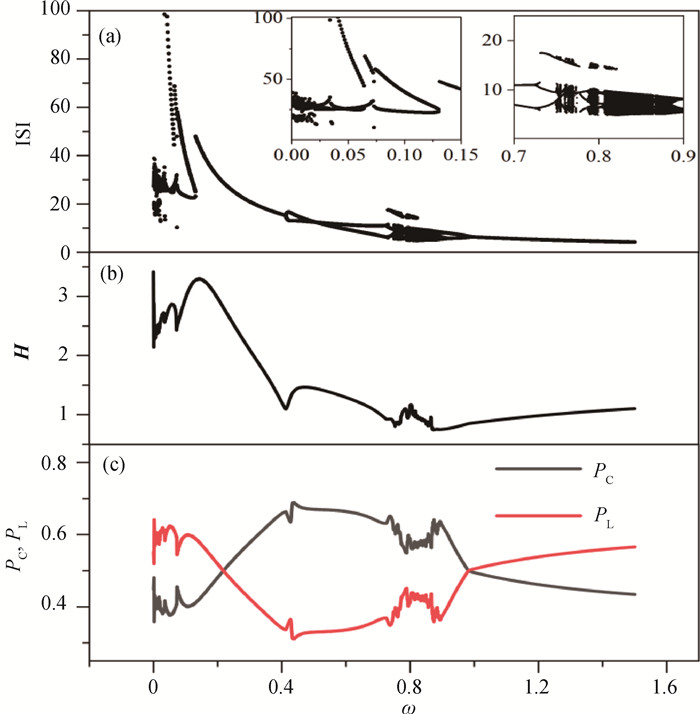
Fig.3 Bifurcation, Hamilton energy and energy proportion of single neural circuit driven by periodic signals (a) bifurcation diagram of ISI vs. the frequency of the periodic stimulus signal (The small image in the figure is a partial enlargement.); (b) dependence of Hamilton energy on frequency of the Periodic stimulus signal; (c) evolution of the electric energy proportion PC and the magnetic energy proportion PL vs. frequency of the periodic stimulus signal (a=0.7, b=0.8, c=0.1, ζ=0.25, A=0.6, the initial value is [0.2, 0.1].)
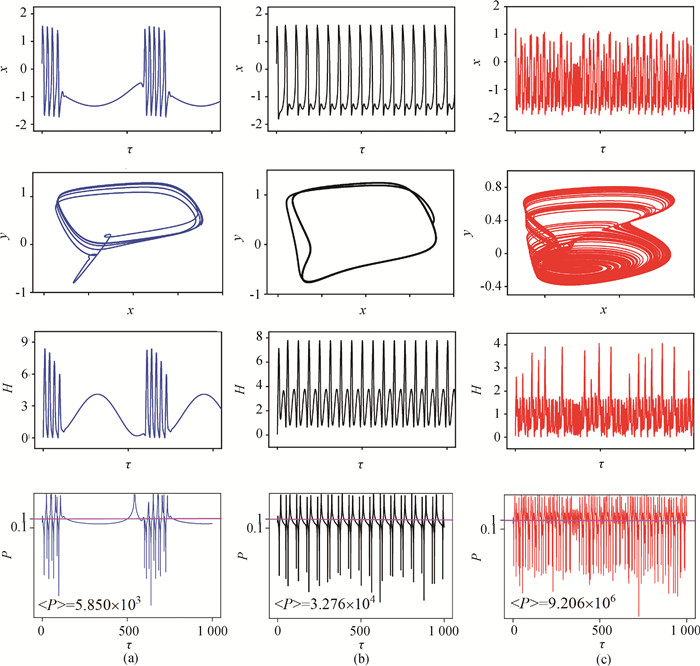
Fig.4 Sampled time series of membrane potential, attractor, the Hamilton energy and evolution of the ratio P between electric field energy and magnetic field energy of single neuron circuit stimulated by periodic photocurrents of different frequencies ω (a) ω=0.01; (b) ω=0.1; (c) ω=0.81 (a=0.7, b=0.8, c=0.1, ζ=0.25, A=0.6. The initial value is [0.2, 0.1].)
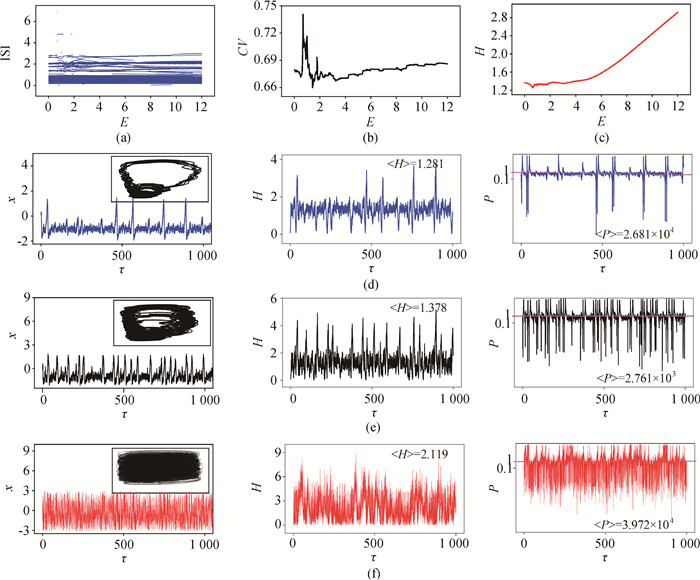
Fig.5 Mode transition, CV distribution and energy evolution of neuron driven by filtered photocurrent signal (a) bifurcation diagram of ISI vs. E. (b) CV vs. E.(c) H vs. E. (d)~(f) are sampled time series of membrane potential (the small image in the figure is the corresponding phase diagram.), Hamiltonian energy H and ratio P of electric field energy to magnetic field energy of neuronal circuit with different amplitude E of filtered photocurrent signal; (d) E=0.69; (e) E=1.43; (f) E=8.4 (a=0.7, b=0.8, c=0.1, ζ=0.25, α=9.78, β=14.97, γ=0.0, m0=-1.31, m1=-0.75. The initial value is [0.1, 0.1, 1, 0.2, 0.1].)
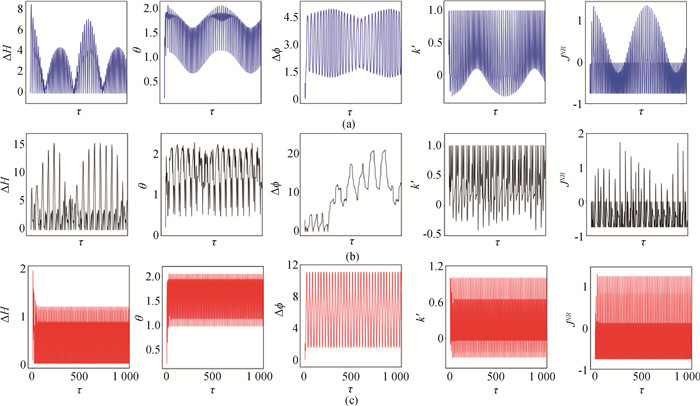
Fig.6 Evolution of energy difference, synchronization error function, phase error, coupling intensity and coupling channel energy consumption of two coupled neurons with different initial states driven by period photocurrent with different frequency (a) bursting pattern, ω=0.01;(b) spiking pattern, ω=0.1;(c) chaos pattern, ω=0.81 (A=0.6, a=0.7, b=0.8, c=0.1, ζ=0.25. The initial value is [0.2, 0.1, 0.02, 0.01].)
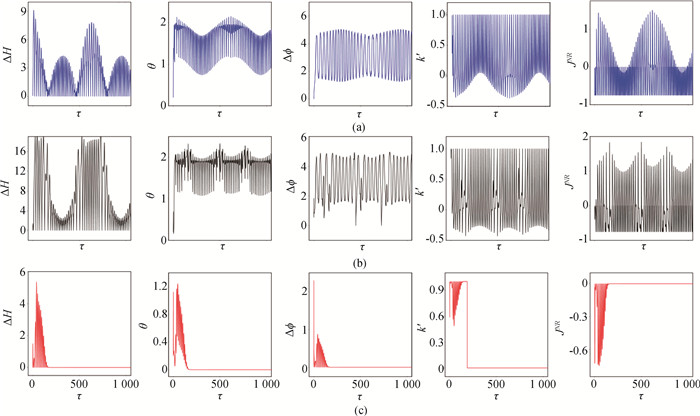
Fig.7 Effect of noise on synchronization state of two coupled bursting neurons (a) D=0.05;(b) D=0.2;(c) D=2.0 (ω=0.01, A=0.6, a=0.7, b=0.8, c=0.1, ζ=0.25.The initial value is [0.2, 0.1, 0.02, 0.01].)
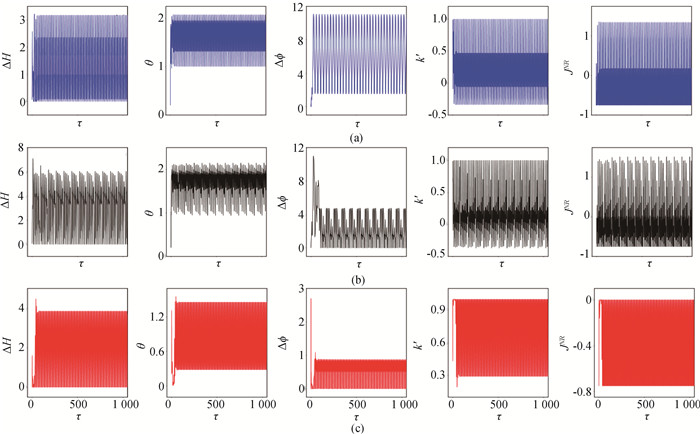
Fig.8 Evolution of energy diversity, error function, phase error, coupling intensity and coupling channel energy consumption in two coupled neuronal circuit with chaotic discharge driven by noise and periodic stimulus (a) D=0.05;(b) D=0.3; (c) D=1.8 (ω=0.81, A=0.6, a=0.7, b=0.8, c=0.1, ζ=0.25. The initial value is [0.2, 0.1, 0.02, 0.01].)
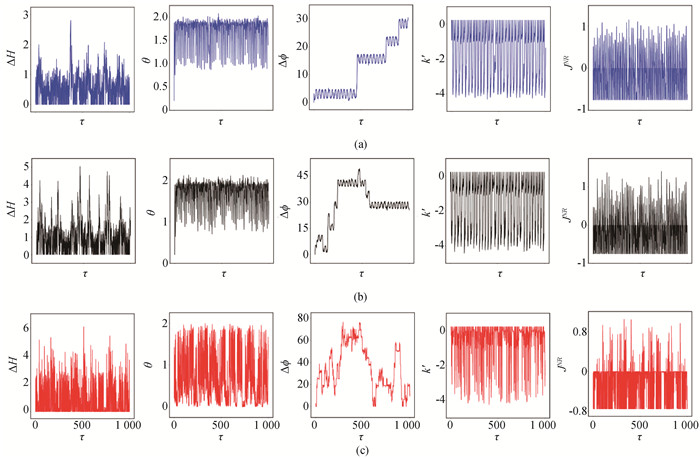
Fig.9 Evolution of energy diversity, error function, phase error, coupling intensity and coupling channel energy consumption in the two coupled neurons by the filtered chaotic photocurrent (a)E=0.69; (b)E=1.43; (c)E=8.4 (a=0.7, b=0.8, c=0.1, ζ=0.25, α=9.78, β=14.97, γ=0.0, m0=-1.31, m1=-0.75. The initial value is[0.1, 0.1, 1, 0.2, 0.1, 0.02, 0.01].)
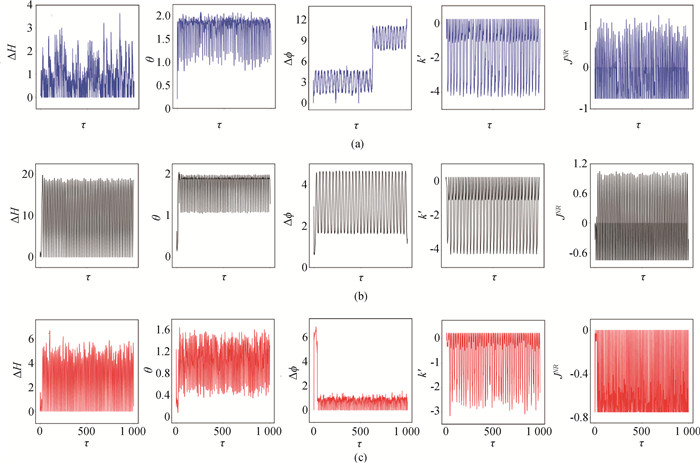
Fig.10 Evolution of energy diversity, error function, phase error, coupling intensity and energy consumption of two coupled neurons driven by filtered chaotic photocurrent with noise (a)D=0.04; (b)D=1.0; (c)D=4.0 (E=0.69, a=0.7, b=0.8, c=0.1, ζ=0.25, α=9.78, β=14.97, γ=0.0, m0=-1.31, m1=-0.75. The initial value is [0.1, 0.1, 1, 0.2, 0.1, 0.02, 0.01].)
| 1 |
马军. 功能神经元建模及动力学若干问题[J]. 广西师范大学学报(自然科学版), 2022, 40 (5): 307- 323.
|
| 2 |
DOI |
| 3 |
DOI |
| 4 |
|
| 5 |
|
| 6 |
DOI |
| 7 |
刘丽君, 韦笃取. 忆阻Rulkov神经网络同步研究[J]. 计算物理, 2023, 40 (3): 389- 400.
|
| 8 |
唐利红, 贺宗梅, 姚延立. 忆阻Hopfield神经网络动力学分析及其电路实现[J]. 计算物理, 2022, 39 (2): 244- 252.
|
| 9 |
DOI |
| 10 |
DOI |
| 11 |
DOI |
| 12 |
薛晓丹, 王美丽, 邵雨竹, 等. 基于抑制性突触可塑性的神经元放电率自稳态机制[J]. 物理学报, 2019, 68 (7): 078701.
|
| 13 |
|
| 14 |
DOI |
| 15 |
|
| 16 |
DOI |
| 17 |
DOI |
| 18 |
DOI |
| 19 |
DOI |
| 20 |
于文婷, 张娟, 唐军. 动态突触、神经耦合与时间延迟对神经元发放的影响[J]. 物理学报, 2017, 66 (20): 200201.
DOI |
| 21 |
李国芳, 孙晓娟. 小世界神经元网络随机共振现象: 混合突触和部分时滞的影响[J]. 物理学报, 2017, 66 (24): 240501.
DOI |
| 22 |
DOI |
| 23 |
DOI |
| 24 |
谭安杰, 韦笃取, 覃英华. 电磁场耦合忆阻神经网络的放电模式及同步行为研究[J]. 广西师范大学学报(自然科学版), 2020, 38 (1): 107- 113.
|
| 25 |
DOI |
| 26 |
DOI |
| 27 |
DOI |
| 28 |
DOI |
| 29 |
DOI |
| 30 |
DOI |
| 31 |
DOI |
| 32 |
DOI |
| 33 |
DOI |
| 34 |
周倩, 韦笃取. 场耦合忆阻神经网络的电活动[J]. 计算物理, 2020, 37 (6): 750- 756.
|
| [1] | ZHAN Jiemin, BIAN Shiqi, LUO Yingying, HU Wenqing, GONG Yejun. Periodicity Analysis and Benchmark Solution of Lid-driven Cavity at Re=15 000 [J]. CHINESE JOURNAL OF COMPUTATIONAL PHYSICS, 2020, 37(4): 413-421. |
| [2] | GAO Fengling, CUI Guomin, TAO Leren, HUA Zezhao, HUANG Xiaohuang. Analysis on Spectral Energy Distribution of Greenhouse Effect Under Global Warming Background [J]. CHINESE JOURNAL OF COMPUTATIONAL PHYSICS, 2014, 31(3): 343-350. |
| [3] | ZHANG Yan, DONG Gang, YANG Yintang, LI Yuejin. An Interconnect Energy Distribution Model Based on Non-uniform Wire-size [J]. CHINESE JOURNAL OF COMPUTATIONAL PHYSICS, 2014, 31(1): 109-114. |
| [4] | LV Shaobo, LIN Zeng, WANG Qing, BA Dechun. Electron Energy Distribution in Radio-frequency CH4 Plasma [J]. CHINESE JOURNAL OF COMPUTATIONAL PHYSICS, 2011, 28(2): 250-258. |
| [5] | ZHUO Jun, HUANG Liuxing, NIU Shengli, ZHU Jinhui. Mixed Monte Carlo Simulation of Electron Backscattering from Solids [J]. CHINESE JOURNAL OF COMPUTATIONAL PHYSICS, 2010, 27(6): 805-810. |
| [6] | CHEN Jong-shun, WANG Chin-shu, WANG Ying-chin. Nano Valve of Medicinal Carrier:A Molecular Dynamics Study [J]. CHINESE JOURNAL OF COMPUTATIONAL PHYSICS, 2008, 25(3): 349-357. |
| [7] | Wang Xinbing, Xu Qiyang, Liu Erwu, Xie Minjie, Li Zaiguang. ELECTRON ENERGY DISTRIBUTIONS, TRANSPORT COEFFICIENTS FOR CO2 LASERS EXCITED BY HIGH FREQUENCY DISCHARGE [J]. CHINESE JOURNAL OF COMPUTATIONAL PHYSICS, 1997, 14(S1): 527-529. |
| [8] | Wang Dezhen, Gong Ye, Ma Tangcai. A MONTE CARLO SIMULATION OF IONS STRIKING THE CATHODE IN A ARGON GLOW DISCHARGE [J]. CHINESE JOURNAL OF COMPUTATIONAL PHYSICS, 1993, 10(2): 215-219. |
| [9] | Wang Dezhen, Liu Yue, Ma Tengcai. ELECTRON ENERGY DISTRIBUTIONS OF DIRECT-CURRENT ARGON DISCHARGES AT LOW PRESSURES [J]. CHINESE JOURNAL OF COMPUTATIONAL PHYSICS, 1990, 7(4): 448-452. |
| Viewed | ||||||
|
Full text |
|
|||||
|
Abstract |
|
|||||
Copyright © Chinese Journal of Computational Physics
E-mail: jswl@iapcm.ac.cn
Supported by Beijing Magtech Co., Ltd.
